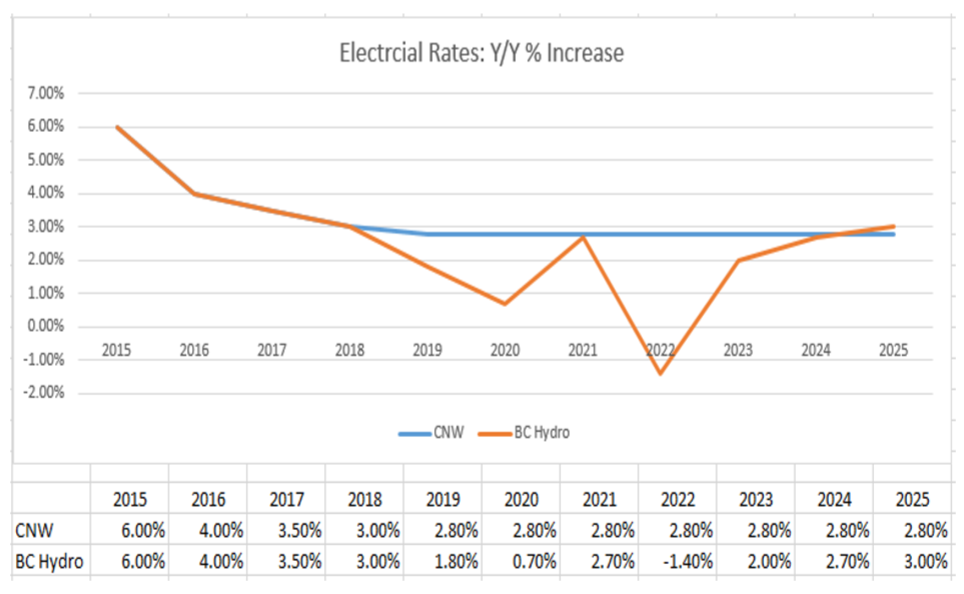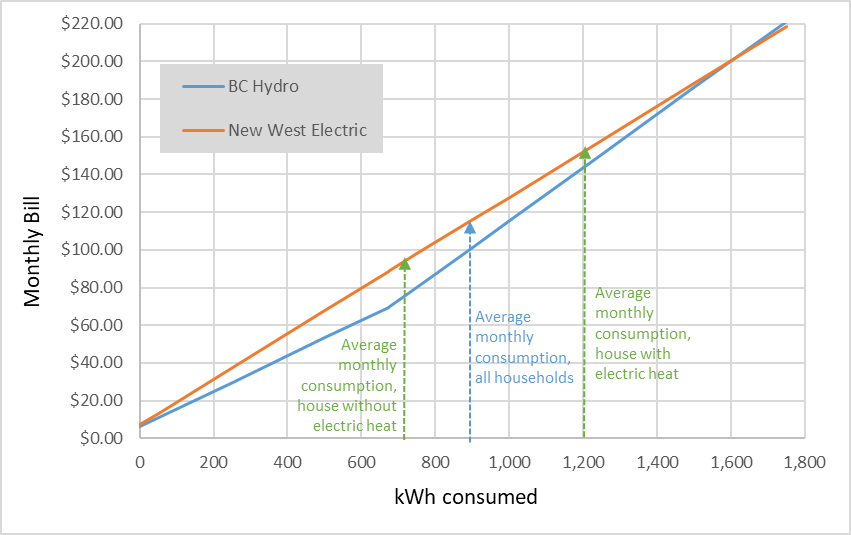Alvin asked—
Not sure if this has been asked before but I was wondering Why New West has municipal/private electric vs Bc Hydro like our surrounding cities? Speaking with friends from other municipality, it seems New West has a higher cost per household? What are the pros and cons of having New West Electric? Thank you!
Yes, this has been asked before, and I answered here, so I suggest you click over there and read that first, because I’m not writing it all again. But that was more than 5 years ago, and the numbers have changed as has some of the governing philosophy. I’m on the Electrical Commission now (though, I hasten to remind folks, I don’t speak here for the City, or for the Electrical Commission; these are my own thoughts, not official communications!), and know a bit more about these things, so maybe a bit of an update to that post is in order.
New Westminster has had its own electrical utility since 1891, when a wood-fired steam turbine started spinning dynamos to provide street lighting in the City. Notably, a group of concerned citizens challenged the City’s legal authority to do this, and went all the way to the Legislature to complain about this extravagant spending (along with the ferry service to Surrey, the public library, an the waterworks), but the New Westminster Light Department prevailed, and 130 years later here we are.
What hasn’t changed: the New West Electrical Utility (NWE) buys electricity at wholesale and sells at retail. The difference between the two is mostly used to operate and invest in the utility, with leftover “profit” that is put into City coffers to add to operations of the rest of the City and offset some property taxes. In the 2020 Budget Reporting (the most recent available online, alas), you can see NWE made about $51M in sales, had about $39M in operational costs (mostly buying wholesale power), and invested about $7M into Capital upgrades (like that new substation in Queensborough), meaning about $5M was put into City operations. That’s $5M less property tax the City had to collect to provide services, or about $160 per household.
What has changed since that 2016 piece I wrote are the electrical rates offered by BC Hydro and NWE. BC Hydro rates are set by some confusing combination of the utility figuring out how exactly much money it needs, the provincial government telling them they can’t have that much, and the BC Utility Commission picking a number based on those two factors. As such, electrical rates have been unpredictable in the last few years, increases being promised, then being reduced, making longer-term financial planning difficult. The NWE process is the Electrical Commission determining how much they need to operate, and Council generally passing a Bylaw to support that (though Council have the power to not approve rate increases). In recent years, the Commission and Council have been more comfortable decoupling a bit from BC Hydro rates as a standard comparison to a model where they assure the capital needs of the Utility are secure for the future (see big substation build in Queensborough) and that rate increases remain more stable as opposed to big increases one year and smaller increases the next. With the BC Government getting support from the BCUC to reduce scheduled rate increases, BC Hydro is in a situation where rate increases are being deferred into the future.
The upshot of that is that NWE rates are currently going up slightly faster than BC Hydro Rates, though we fully expect BC Hydro will need to catch up to us in the near future. This was demonstrated with the following graph in our recent Council budget deliberations:
I note that 2023-2025 rates, both BC Hydro and NWE, are speculative right now, and BC Hydro will face the need to pay for some significant infrastructure soon, so it is generally thought BC Hydro will catch up to NWE within the current 5-year plan. In the meantime, we have some capital expenses that cannot wait (did I mention that big substation in Queensborough?) and will be able to re-evaluate comparative rate increases on a year-by-year basis.
The upshot of all this is that rates for NWE have gone up a bit compared to BC Hydro. I drew a comparison chart back in 2016, and did my best to recreate it using the proposed 2021 rates: 
The shape of the chart has not changed, but the gap has increased a bit. That means for the “average” household in New West (assuming their energy consumption is the same as the average for BC) pays about 14% more for their electricity every month than the BC average. This gap gets lower the more energy a household uses, in that BC Hydro’s scaled rates “catch up” to NWE rates. The difference, again for the “average” household is about $160 a year, which almost exactly offsets the “average” property tax savings per household. Rate differences for households more than a standard deviation from “average” – who use much more or much less than average monthly electricity – are are probably pretty small. All “averages” are in quotes here, because I don’t want to get into the discussion of means and medians, or the differences between a $500,000 condo and a $2,000,000 house when it comes to property tax burden and electrical consumption, but it is fair to say the structure we have now slightly benefits larger households, but perhaps incentivizes electrical conservation.
Even if the rate gap is such that there is no longer a financial advantage to having our own utility, there are arguments for the utility aside from financial. By owning poles and rights of way, the City can leverage that for its own purposes, from BridgeNet to negotiating with Telecoms for pole space. By selling electricity to transportation providers, we have access to Low Carbon Fuel Credits to fund climate action. The structure of the Utility may lend itself to a more efficient operation of a District Energy Utility. Because of NWE, we have ability to manage our own Net Metering, allowing people to co-generate and easily sell their rooftop power to the grid, and even allowed us to create two successful and operational Solar Gardens for those without sufficient roof space. There are also opportunities for NWE to lead, as the community and the province shift to electrification to meet our Climate Action goals, such as piloting Street Light EV charging or rolling out Heat Pump incentive programs to get homes off of fossil gas. We also have one of the most reliable grids in the province, with faster response to power outages, and fewer and shorter outages than in most places in the Province.
Is the street light EV charging still a pilot program? Is it a success? Will it be expanded to other locations in New Westminster?
What is the best source of information for the City’s plans for future roll outs of their EV charging network?
One more question : when are we moving to smart metering?
on the BCIT pilot, there were a few teething issues and lessons learned, but the system seems to be working now. Its more complicated than I imagined, as it has a system to “share” excess line capacity with the shift to LED lights. I cannot tell you what the next steps are with this program, as We haven’t had a report on it yet.
The Electrical Utility has something like $10M in its current capital plan to upgrade meter technology. Not the same “smart meter” system as BC Hydro, but modern digital metering tech with many of the advantages. https://www.newwestcity.ca/ami